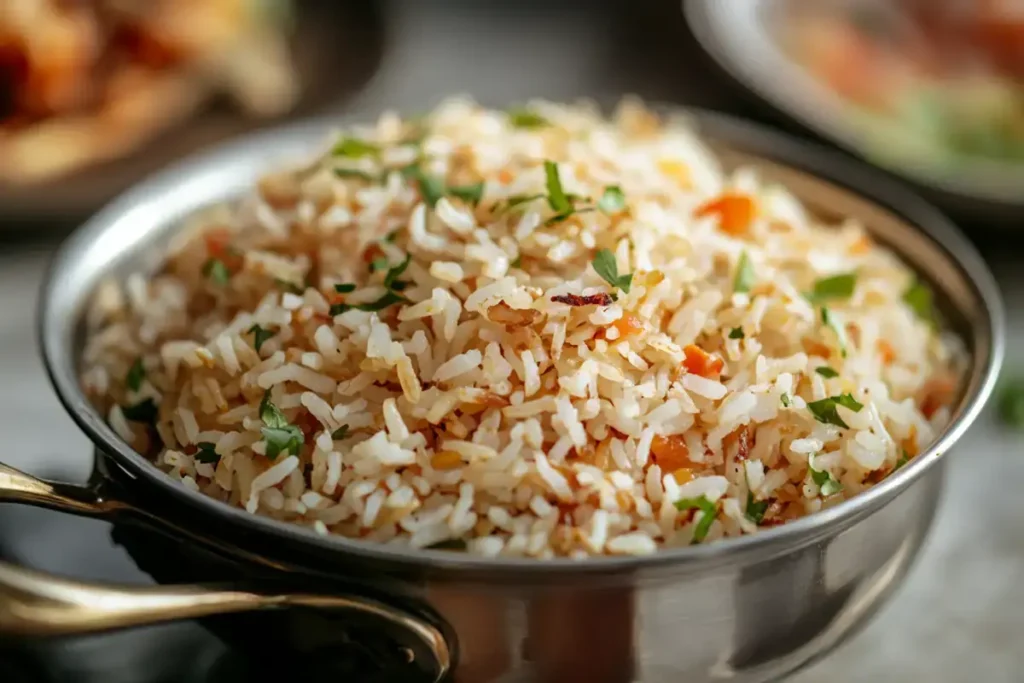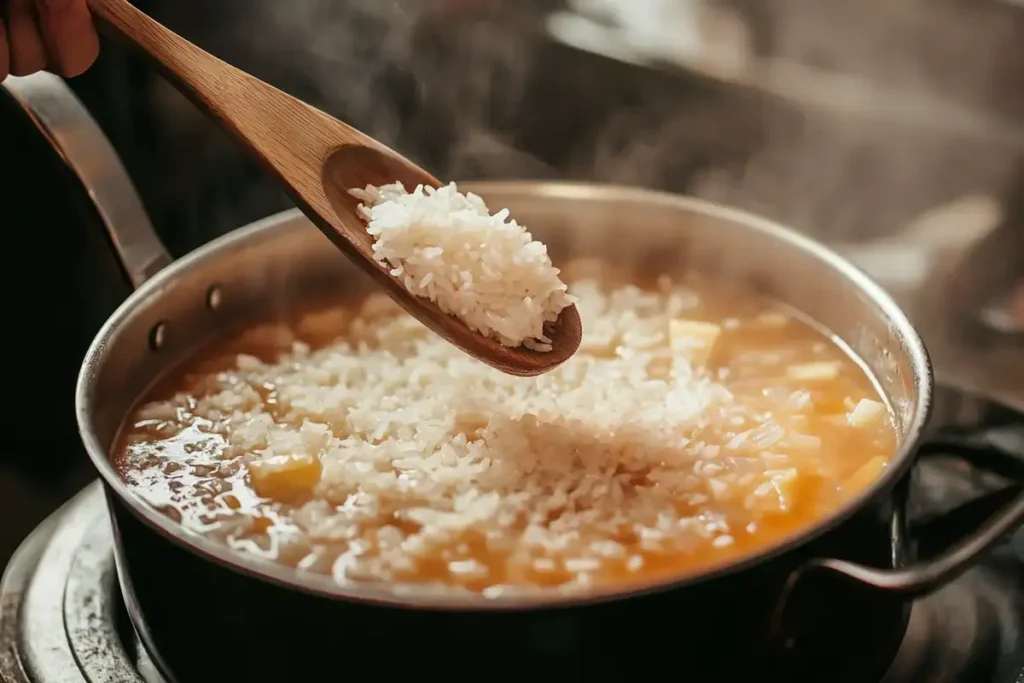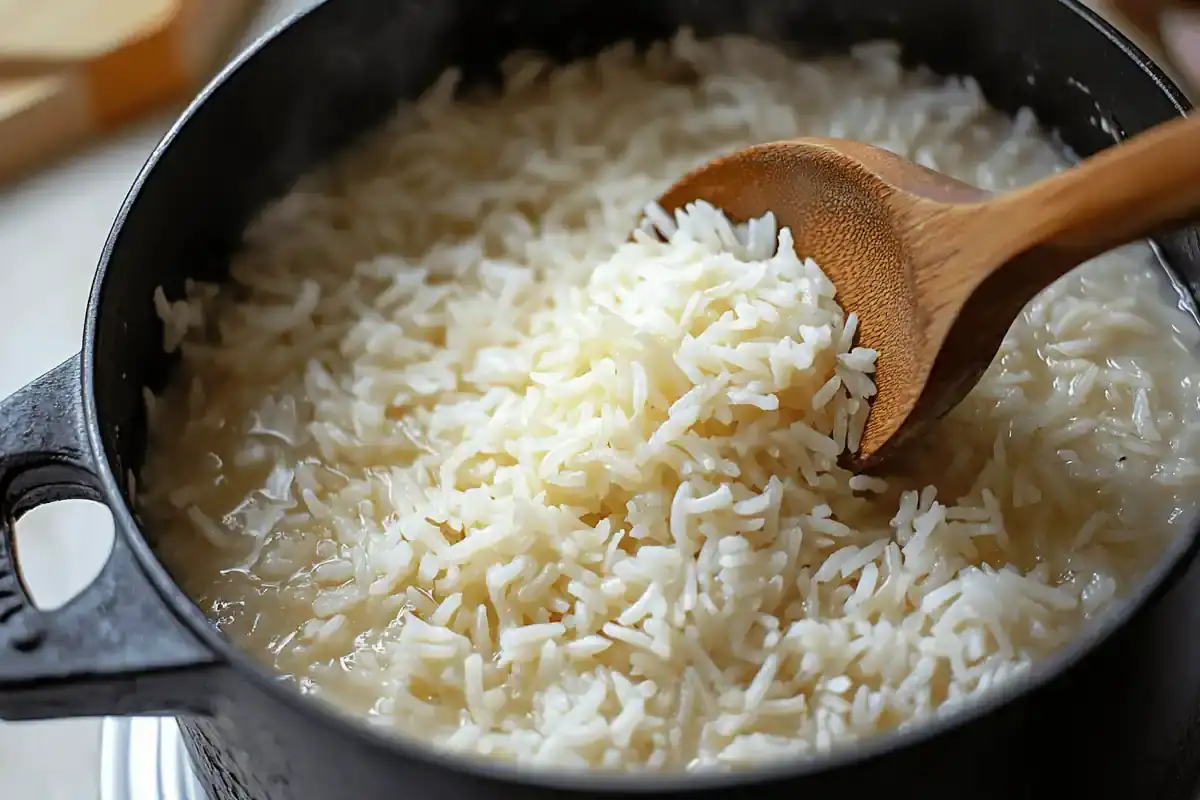This article explores if you should cook rice before adding to soup. Learn the best methods for perfectly cooked rice in your soups.
Table of contents
- Understanding Rice and Soup Dynamics
- The Case for Cooking Rice Separately
- Adding Raw Rice Straight into Soup
- Flavoring and Texture Tips for Rice in Soup
- Step-by-Step Guide to Adding Pre-Cooked Rice to Soup
- Step-by-Step Guide to Adding Uncooked Rice to Soup
- Alternatives to Rice in Soup
- Conclusion
- Frequently Asked Questions (FAQs)
Understanding Rice and Soup Dynamics
Rice is a versatile grain. It becomes soft when cooked in liquid. Therefore, understanding how rice behaves in soup is crucial. Rice absorbs the liquid. Consequently, it can significantly alter the soup’s consistency. Cooking rice directly in a large volume of liquid can affect both the rice and the soup. It is also important to consider the type of rice you use. Different varieties of rice behave differently in soup.
Different Types of Rice and Their Suitability for Soups
There are different types of rice available. Long-grain rice is one common type. It tends to stay separate when cooked. In contrast, short-grain rice can become sticky. Brown rice is a whole grain and takes longer to cook. White rice cooks faster. Therefore, these differences are important to consider when adding rice to soup. The type of rice you choose affects the final outcome. Also, the variety will influence the cooking process. Consequently, some rice varieties are more suitable for soup than others. For example, using short-grain rice is more likely to result in a thicker soup.
How Rice Impacts the Overall Consistency of Soup
Rice acts as a natural thickening agent. When cooked in soup, rice releases starch. This starch then contributes to the overall texture. Rice can also absorb large amounts of the broth. Therefore, this can result in a thicker, heartier consistency. If not managed well, the soup can become too thick. This is especially true if the liquid to rice ratio is incorrect. For instance, adding too much rice can transform your soup into a stew. It is important to take into account these factors. Therefore, you can control the final consistency of your soup.
Transitioning to the subsequent portion, we will now consider whether you should cook rice before adding to soup.
The Case for Cooking Rice Separately

Pre-cooking rice allows better control over texture.
Cooking rice separately offers many advantages. This method allows for greater control over the texture. Rice is less likely to become mushy. Additionally, this approach helps to prevent a starchy soup. Consequently, you can achieve a better final product. Cooking rice separately also ensures that the grains are evenly cooked. You can therefore get perfect rice every time.
Benefits of Pre-cooking Rice
Pre-cooking rice offers multiple advantages. It allows better control over texture and prevents overcooking. Separately cooked rice absorbs less broth, keeping your soup from becoming starchy. You can stop the cooking process when the rice is perfectly done and add it to the soup at the last minute, preventing it from soaking up too much liquid. This method also lets you use flavorful liquids like broth instead of water, resulting in fluffy, well-cooked grains. Additionally, pre-cooking gives you precise control over the rice-to-liquid ratio and adds flexibility to meal planning.
How to Cook Rice Separately for Soup
Cooking rice separately is easy. There are a few ways to do so. You can use a stovetop or a rice cooker. For the stovetop, bring water to a boil. Then, add the rice and reduce heat. Cover and simmer until the rice is tender and all the liquid is absorbed. A rice cooker simplifies the process further. This appliance cooks the rice to perfection. It shuts off automatically once the rice is done. Always use the correct water-to-rice ratio. This is important to ensure that the grains are cooked properly. Once cooked, fluff the rice with a fork. This will keep the grains from sticking together. This approach is convenient and time saving. You can also store the cooked rice in the fridge for future use. According to the USDA, proper storage is critical to prevent bacterial growth.
When Pre-cooking Is Especially Recommended
Pre-cooking is particularly useful. This is especially true when using certain rice varieties. Short-grain rice is more likely to become sticky and mushy. Therefore, pre-cooking is recommended. Delicate soups or broths also benefit. The rice won’t cloud the broth with excess starch. This method helps maintain a clear and flavorful base. In addition, pre-cooking the rice is beneficial when you are preparing a formal meal. This way, the texture and taste of the final product will be more consistent and appealing. Moreover, pre-cooking is advantageous if you want to enhance the flavor. For instance, you can cook the rice in seasoned broth. Therefore, you can add flavor to it before it goes into the soup.
Advancing to the following area, we’ll explore situations where adding uncooked rice to the soup is suitable.
Adding Raw Rice Straight into Soup

Adding uncooked rice to the soup thickens it naturally.
Adding uncooked rice directly to soup can be acceptable. This is true in specific situations. This method works best with hearty soup bases. For example, broth-based soups. When the goal is to thicken the soup, it can also work well. Also, long-grain rice varieties work better with this approach.
Situations When Direct Addition of Rice is Acceptable
There are specific situations. These are times when adding rice directly to soup is okay. Firstly, hearty, broth-based soups are suitable. For example, vegetable, chicken, or minestrone soups. Secondly, when the intention is to thicken the soup, this method is very useful. Rice will absorb liquid and release starch. This will make the soup heartier. Thirdly, long-grain rice varieties are the best option. They can withstand longer cooking times without becoming mushy. For instance, using rice in a classic tomato soup can work very well. Moreover, this approach is ideal when you’re aiming to make a more substantial dish. When a thicker consistency is your preference, this method works well.
Proper Technique for Cooking Rice Directly in Soup
Cooking rice directly in soup requires careful attention. Adjust the liquid levels to account for rice absorption. You need to monitor cooking times carefully. Prevent the rice from sticking to the pot. Use a heavy-bottom pot and stir occasionally. These simple steps will help you achieve the desired result. You will also need to check the rice for doneness periodically. This can help avoid overcooking. Rice should be tender, not mushy. This method can be convenient, but it requires practice. However, this method can also enhance the flavors of the soup and the rice. As the rice cooks, it absorbs all the flavors in the soup. This will create a very tasty result.
Potential Drawbacks of Cooking Rice Directly in Soup
Cooking rice directly in soup has potential drawbacks. Firstly, the rice can become mushy easily. Secondly, the soup may become overly thick or starchy. Thirdly, there is a risk of uneven cooking. For instance, if you don’t stir often, the rice can stick to the bottom of the pot. This means that some rice will overcook while others undercook. There is also less control over the final texture and flavor. When you cook the rice separately, you can season it before adding it to the soup. It also gives you flexibility and more control over the whole process.
In the next installment, we will talk about flavoring and texture tips for rice in soup.
Flavoring and Texture Tips for Rice in Soup
Enhancing the flavor of rice in soup is simple. You can cook the rice in flavorful broth. Additionally, you can toast the rice before adding it to the soup. Adding herbs and spices will also boost the flavor. When it comes to the texture of the rice, proper liquid ratios are very important. Also, you can add a splash of lemon juice to improve the overall flavor. These simple tips help you achieve the best results.
Enhancing Flavor Before Adding Rice to Soup
Adding flavor to rice is easy. You can cook the rice in chicken, vegetable or beef broth. Also, toasting the rice in a dry pan before adding it to the soup adds a nutty flavor. Herbs and spices added to the cooking liquid will also enhance its flavor. You can use bay leaves, thyme, or garlic. These simple steps make a big difference to the overall taste. Cooking the rice separately also gives you the opportunity to season the grains. This method is useful if your soup base is mild. By adding spices and herbs, you can further customize the taste to your liking.
Improving Texture for Both Pre-cooked and Raw Rice
Maintaining the perfect texture is crucial. If you are using pre-cooked rice, add it at the end. This prevents it from becoming mushy. It also prevents it from absorbing all the broth. For rice cooked directly in soup, use the right liquid ratio. Adjust the liquid levels as needed. A splash of lemon juice when cooking the rice can help keep grains separate. However, do not overcook the rice, you can always add more if you need to. Pay close attention to the rice as it cooks. You want it to be tender but not mushy. Also, stirring regularly can prevent the rice from sticking to the pot.
Dealing with Overcooked Rice in Soup
Overcooked rice is a common issue. If the rice is already too mushy, there are methods to help fix it. Firstly, you can try adding more liquid to the soup. Secondly, you can add a thickening agent, like cornstarch to counterbalance the excess starch. You can also add acid, like lemon juice. This can cut through the starchiness. There are other measures you can take. For example, you can use modifications in the recipe. For instance, add more vegetables to the soup. Although, the best approach is to try to prevent overcooking. However, even overcooked rice can still be enjoyable in the soup. You can also blend it to make a creamy soup. This is a good way to make the most of your meal.
Proceeding to the next chapter, let’s focus on a step-by-step guide for adding pre-cooked rice to soup.
Step-by-Step Guide to Adding Pre-Cooked Rice to Soup
Adding pre-cooked rice to soup is straightforward. The process mainly involves adding the rice at the right time. This will ensure the texture is not compromised. The timing is crucial to ensure the rice does not overcook. You also want to prevent the grains from breaking down in the soup. Adding the rice at the end of the cooking process is key.
Overview of the Process
The process is very simple. You cook the rice separately. Then, you add it to the soup at the end. This prevents the rice from becoming mushy. This also ensures the soup does not become too starchy. There are a few different methods, depending on the temperature of the rice and soup. However, the main principle is to add the rice when the soup is almost ready.
Detailed Steps for Adding Cooked Rice to Various Soup Types
For most soups, add the cooked rice during the last five to ten minutes of cooking. You want to ensure the rice is heated through but not overcooked. If you’re adding hot rice to a cold soup, stir it in until it’s warmed through. Similarly, if adding cold rice to a hot soup, add it just before serving. Stir it in gently, and let it warm through. You can also reheat rice in soup. However, do so gently. Avoid boiling the soup rapidly, as this can make the rice mushy. Additionally, using these steps will preserve the flavor of the soup and the texture of the rice.
Practical Examples
For example, when adding rice to chicken noodle soup, stir it in during the last five minutes of simmering. The rice will heat through and absorb some of the broth. When adding rice to a vegetable broth, you can use this method as well. Another practical example is adding rice to a creamy soup. In this case, add the rice after you’ve blended the soup. Add the rice during the last few minutes before serving. This will prevent it from becoming too soft. In every case, ensure that you do not overcook the rice. It should just warm through and retain its texture.
Transitioning into the following chapter, let’s now explore how to add uncooked rice directly into soup.
Step-by-Step Guide to Adding Uncooked Rice to Soup
Adding uncooked rice to soup needs a different technique. Adjust the cooking time and liquid levels accordingly. Make sure you check for rice doneness. This will prevent the rice from sticking to the pot. The whole process is about making sure the rice cooks evenly. Therefore, patience is required.
Overview of the Process
The process of adding uncooked rice directly to soup involves adding the rice to the soup during the cooking process. You also need to monitor the soup. The rice will need time to soften, so be sure to adjust your cooking times. Pay close attention to the liquid levels. Rice will absorb liquid as it cooks. As a result, it is essential to adjust the soup if needed to maintain the desired consistency.
Detailed Steps for Adding Uncooked Rice to Various Soup Types
When adding uncooked rice to soup, start by adding it to the broth. Then, bring the soup to a simmer. Adjust the cooking time based on the type of rice. White rice will need around 15 to 20 minutes. Brown rice will need about 40 to 45 minutes. Always check the rice for doneness. Stir it occasionally. The rice should be tender and fully cooked. Add more liquid if the soup becomes too thick. If you are adding rice to a tomato-based soup, it may need less liquid as tomatoes already contain a large amount of liquid. Adjust accordingly. For broth-based soups, add the rice and simmer gently. Ensure the heat is low and the soup does not boil rapidly.
Practical Examples
For example, when making minestrone soup, you can add rice along with other vegetables. Then simmer until the rice is tender. When cooking rice in tomato-based soups, use the same method. Ensure you monitor the liquid levels and make adjustments. Finally, when adding rice to a Thai soup, adjust cooking time based on the type of rice. Often, Thai soups are broth-based, so monitor carefully to prevent overcooking. Remember that every type of soup is different. The key is to adjust the timing and liquid to ensure the rice cooks properly.
In the succeeding section, we will discuss alternatives to rice in soup.
Alternatives to Rice in Soup
There are alternatives to rice in soup. Other grains and starches are suitable. Barley, quinoa, and pasta are a few examples. These alternatives provide different flavors and textures. Consequently, choosing the right one depends on your preferences and dietary needs. For example, barley has a nutty flavor and provides a chewy texture.
Exploring Other Grains and Starches for Soups
Other grains and starches can be used. They offer a variety of textures. Barley has a chewy texture and a nutty flavor. Quinoa is a complete protein. It has a slightly nutty taste and fluffy texture. Pasta offers a variety of shapes. It adds texture and substance to soups. Each of these options offers different nutritional benefits. Additionally, they will change the texture of the soup. Therefore, choose the grain that fits your needs. These alternatives can enhance the complexity and flavor of your soups.
Comparison of Flavor and Texture with Rice
Barley adds a chewy texture and a nutty flavor. It is different from rice, which is softer. Quinoa provides a light and fluffy texture. It also offers a slightly nutty flavor. Pasta, depending on the shape, varies widely in texture. It can also change the consistency of the soup. Each option provides its own unique characteristics. This is unlike rice, which offers a neutral flavor. Consequently, you can use these variations to make interesting soups.
When to Choose Alternative Starches over Rice
Choose other starches when you want something different. For example, you may need a different texture or flavor. If you have a gluten allergy, you might consider rice, quinoa, or other gluten-free grains instead of pasta. If you want a very hearty soup, use barley as it will add bulk. The other reason is that you can add more nutritional value to your soup. Quinoa, for instance, is a great source of protein and fiber. Ultimately, your preference and dietary needs should determine your choice.
Conclusion
In conclusion, deciding whether to cook rice before adding to soup depends on various factors. Both methods are useful for different situations. Pre-cooking offers control over the texture. Adding uncooked rice directly into soup is convenient. Understanding the pros and cons of each method is important. This will help you make the best choice. Consider your preferences and the type of soup you are making. This will lead you to delicious results every time.
Ultimately, the best approach to adding rice to soup is to experiment. With practice, you will be able to cook the perfect rice every time. Always consider the type of soup, the type of rice, and the desired consistency. Enjoy the process and the delicious outcome. So, next time you’re making soup, think about which method is best for you. Try different techniques to discover your favorite way to cook rice. Happy cooking!
Frequently Asked Questions (FAQs)
It’s common to have questions about cooking rice in soup. Here are some of the most frequently asked questions. These questions address common issues and best practices when working with rice in soups.
Cooked rice is best added at the end to avoid mushiness, while uncooked rice can go directly in but may thicken the soup. Choose based on texture preference and adjust cooking times as needed.
Cook rice separately and add it at the end. If using uncooked rice, monitor closely to avoid overcooking. Maintain the right rice-to-liquid ratio and consider adding a splash of lemon juice to help retain texture. Timing is key!
Rinsing rice before adding it to soup helps remove excess starch, reducing the risk of overly thick or cloudy soup. While not always necessary, it’s especially useful when cooking rice directly in the soup.
Yes, you can enhance cooked rice with herbs, spices, flavored oils, or a touch of butter. Adding broth or a splash of lemon or lime juice also works well, especially when pairing the rice with a mild soup.

